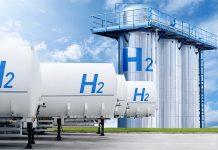GenCell Energy, an Israel-based manufacturer of fuel cell energy solutions, announced that a Tier One telecom provider has deployed its first GenCell G5 hydrogen fuel cell-based long-duration backup solution at an active cell tower site in Europe. This deployment is in alignment with the provider’s corporate sustainability strategy to cut carbon dioxide emissions.
The rugged zero-emission G5 unit has been designed to withstand a wide range of temperatures and weather conditions and will kick in immediately to keep the cell tower operational in the event of a grid outage of any duration. The G5 was installed with six cylinders of hydrogen that will keep the solution running for extended durations with minimal maintenance or service.
The GenCell IoT remote management software provides real-time operational intelligence, allowing engineers at the telecom provider’s headquarters to regularly monitor equipment status to ensure optimal performance. By relying on the G5 to backup cell sites, the provider will be able to avoid the high costs, complexity and emissions involved in operating and maintaining diesel generators across remote cell sites. Because the cell sites have limited space for fuel storage and are especially difficult to reach by road in cold, snowy winters, frequent refuelling of diesel backup generators was costly and problematic; the virtually maintenance and service-free G5 will eliminate this drawback.
“We at Messer are pleased to partner with GenCell to ensure smooth and uninterrupted service for this telecom service provider customer and to be a part of this important project,” comments Diana Buss, Senior Vice President Communications, Messer Group. “As we see increasing regulations aiming to eliminate carbon emissions and to accelerate the transition to clean energy sources throughout Europe and around the globe, more customers are showing interest in moving to hydrogen as well as to the ultimate hydrogen carrier, ammonia. We are excited to collaborate with GenCell to leverage this and other opportunities to provide resilient, cost-effective and emission-free hydrogen-based fuel cell solutions that ensure reliable backup and off-grid power.”
As the telecom industry leads the world in strong and consistent support of sustainability and clean energy, this telecom provider like many others is committed to creating sustainable societies through low-carbon solutions and innovations and to maximizing joint strategies with its suppliers to minimize its carbon footprint. In line with its ambitious objectives to drastically and rapidly cut carbon emissions, deploying fuel cells to back up cell towers in locations suffering from grid instability can significantly reduce diesel combustion.
Following investments in solar and wind-powered base stations, this Tier One telecom supplier has now decided to diversify its investment in renewable energy by implementing hydrogen fuel cells to enjoy the benefits of ultrareliable, long-duration energy storage with zero carbon emissions and minimal on-site maintenance or servicing. Operating thousands of remote cell sites across Europe and around the globe where often power grids experience instability and outages, telecom providers require efficient, failsafe backup power sources to kick in immediately during outages to maximize network availability and quality of service.
“GenCell applauds our customer and the forward-thinking telecom industry on their uncompromising dedication and resolute leadership role in transitioning the telecom industry to sustainable energy,” commented Amit Ashkenazi, GenCell VP Global Sales. “Especially during the impact of Coronavirus when uninterrupted digital connectivity has become even more critical, further magnifying the importance of telecom services, we are pleased to collaborate with the professional and technologically advanced engineering team servicing this site and are proud to have demonstrated that hydrogen fuel cells serve as a critical, cost-effective and exceptionally reliable power resource that keeps cell towers running 24/7 in any conditions while protecting the environment.”



